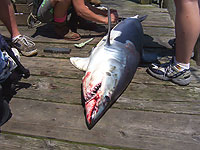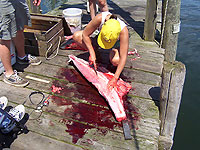|
|
Journals 2003/2004
Deborah Field
South Windsor High School, South Windsor, Connecticut
"Age and Growth of Pelagic and Large Coastal Sharks Using Vertebral Growth Bands"
NOAA Fisheries- Narragansett Laboratory, Rhode Island
July 28 - August 8, 2003
|
Sunday July 13, 2003
Shark Tournament, Snug Harbor, RI
I met Lisa and Cami a week ago at our orientation meeting. Lisa invited me to join them at the shark tournament today, to get a chance to see sharks up close and see how they collect the vertebral column samples they use for their research. I talked my husband into coming along for the ride (he loves to fish & really wants a boat). It turned out to be a beautiful day- sunny & 80 degrees with just enough breeze off the water to cool things off. We met about 1:30 pm at Snug Harbor Marina, in a little bay with several other marinas, a quaint little lighthouse, and a beautiful view of Narragansett Bay. Lisa and her 2 interns were waiting at the end of the dock for the boats to come in.
My first impression of Lisa was - "she's my type of researcher!" Lisa does her field work in tank tops, shorts, & work boots, not unlike how I do mine at school. I have had other teachers question whether or not I can "control" my classes when I'm dressed in jeans, t-shirts, & sneakers 2 or 3 days a week. But I spend a good part of the day climbing up & down step ladders and submerging myself to the shoulders in fish tanks or wading in and out of streams, collecting macroinvertebrates. Can't do that stuff in a suit and my students have told me they really don't care what I wear. The researchers at the company I worked for were all "suits" and I always felt like that wasn't "real" research.
 Lisa introduced me to Jeff, who is a UNH student, working at NOAA for the summer, and Sabrina, who is a high school student from New York, also on a summer internship. Boats started coming in around 2:00pm. The 3rd boat had a shark - a 104lb. male Mako, about 5 feet long. This shark was too small to qualify for the tournament, but the fishermen wanted to know how much it weighed so they brought it in anyway. Lisa asked if she could collect samples and told the guys they'd get the shark filleted for free, so they were quite willing to participate. Lisa & Jeff proceeded to weigh & measure the shark, measure the claspers (male shark reproductive organs), then open the shark up. They removed the liver first, which takes up about _ of the inside of a shark. Then they measured the testes and epididymis and take a section of each testis for another researcher's project. I got passed the testes to put into sample tubes. The shark's stomach was empty except for the piece of mackerel that was used as bait. I thought that was interesting - I figured it would have at least parts of some fish. Lisa then very deftly filleted the shark, removing the head, and cut the entire vertebral column out. The fishermen got the fillets & the head (shark jaws are VERY popular) and Lisa sent Jeff to put the column on ice in her truck. The whole process took about 20 minutes.
 I think all animals are very important, but I eat meat and hunt andfish, but we only take what we can eat; otherwise we don't take it at all. Before working on this project, I was kind of neutral about sharks. I respect their position in the food web & recognize that most people who hate them are afraid- humans just don't like the idea that something might actually eat us. It has bothered me for a number of years the attitude of a lot of people toward large predators (mammal or fish). I actually overheard someone on the dock say, "the only good shark is a dead shark". This is the first time I have seen a shark outside of an aquarium, except for the preserved dogfish my students dissect each year. This shark was beautiful, not very big - I think certainly not big enough to be scary looking. He was a perfect torpedo shape; exactly what the textbooks say is perfect form for fast attack swimming.
|
|